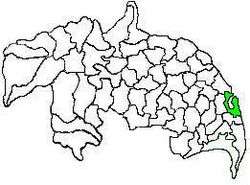Kollur mandal
Kollur mandal is one of the 57 mandals in Guntur district of the Indian state of Andhra Pradesh. It is under the administration of Tenali revenue division and the headquarters are located at Kollur.[3]
Kollur mandal | |
|---|---|
 Mandal map of Guntur district showing Kollur mandal (in green) | |
.svg.png) Kollur mandal Location in Andhra Pradesh, India | |
| Coordinates: 16°11′05″N 80°47′46″E | |
| Country | India |
| State | Andhra Pradesh |
| District | Guntur |
| Headquarters | Kollur |
| Government | |
| • Body | Mandal Parishad |
| • Tehsildar | A. Sheshagiri Rao |
| Area | |
| • Total | 108.14 km2 (41.75 sq mi) |
| Population (2011)[2] | |
| • Total | 55,323 |
| • Density | 510/km2 (1,300/sq mi) |
| Languages | |
| • Official | Telugu |
| Time zone | UTC+5:30 (IST) |
Geography
The mandal is situated on the banks of Krishna River, bounded by Vemuru, Bhattiprolu and Kollipara mandals.[3]
Demographics
As of 2011 census, the mandal had a population of 55,323. The total population constitute, 27,709 males and 27,614 females —a sex ratio of 997 females per 1000 males. 4,876 children are in the age group of 0–6 years, of which 2,509 are boys and 2,367 are girls. The average literacy rate stands at 69.31% with 34,967 literates.[2] Kollur is the most populated and Boddulurupadu is the least populated villages in the mandal.[1]
Administration
The present tahsildar is A.Seshagiri Rao.[4] The mandal also forms a part of the Andhra Pradesh Capital Region, under the jurisdiction of APCRDA.[5]
Politics
Kollur mandal is one of the 5 mandals under Vemuru (SC) (Assembly constituency), which in turn represents Bapatla (SC) (Lok Sabha constituency) of Andhra Pradesh.[6]
Settlements
As of 2011 census, the mandal has 12 revenue villages, 24 gram panchayats and no towns.[7]
The settlements in the mandal are listed below:
- Ananthavaram
- Boddulurupadu
- Chilumuru
- Chinapulivarru
- Donepudi
- Gajullanka
- Guruvindapalle
- Ipur
- Kollur
- Pedalanka
- Potharlanka
- Ravikampadu
- Krapa
- Avulavari palem
- Kishkindapalem
- Tadikilapudi
- Juvvalapalem
- Sugguna Lanka
See also
- List of mandals in Andhra Pradesh
- List of villages in Guntur district
References
- "District Census Hand Book : Guntur (Part B)" (PDF). Census of India. Directorate of Census Operations, Andhra Pradesh. 2011. pp. 14, 468. Retrieved 1 June 2019.
- "Census 2011". The Registrar General & Census Commissioner, India. Retrieved 25 August 2014.
- "District Census Handbook : Guntur (Part A)" (PDF). Census of India. Directorate of Census Operations, Andhra Pradesh. 2011. pp. 5, 770–771. Retrieved 5 June 2019.
- "List of Tahsildars working in Guntur District as on 19.06.2014" (PDF). Guntur District Official Website. National Informatics Centre. p. 1. Archived from the original (PDF) on 16 October 2014. Retrieved 8 September 2014.
- "District wise mandals and villages covered in Krishna and Guntur districts" (PDF). Andhra Pradesh Capital Region Development Authority. Government of Andhra Pradesh. Archived from the original (PDF) on 23 September 2015. Retrieved 23 September 2015.
- "Delimitation of Parliamentary and Assembly Constituencies Order, 2008" (pdf). Election Commission of India. pp. 22, 31. Retrieved 11 October 2014.
- "Hand Book of Statistics 2013 Guntur District" (PDF). pp. ix. Retrieved 9 September 2016.